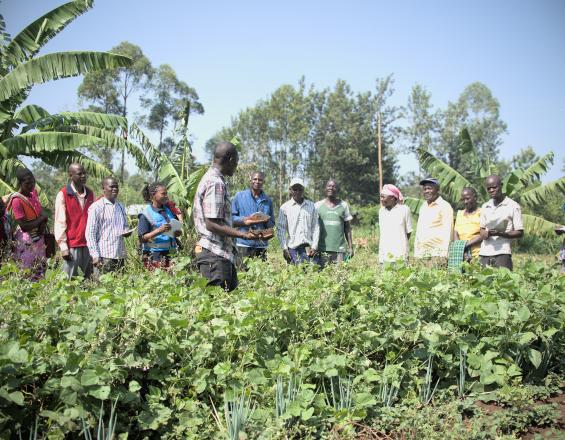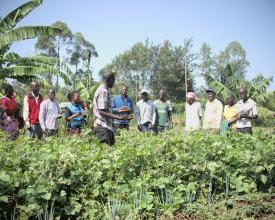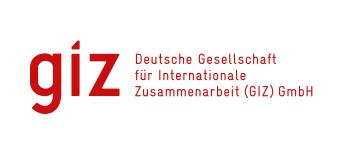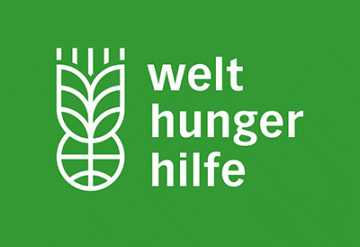
Long-term financing of SLM extension services through a carbon certification scheme

The farming system of Western Kenya is characterized by small-scale subsistence agriculture, with low inputs, low yields, and rapid loss of soil fertility, while there is a lack of financing for long-term extension services on sustainable land management(SLM). Therefore, a carbon certification scheme for soil conservation measures connected to the voluntary carbon market has been set up. Instead of receiving direct payments, farmer families participating in the scheme profit from the proceeds of the carbon revenues through an investment into a community benefit-sharing mechanism. This system provides bi-annual extension services on SLM for the next 20 years. A local not-for-profit entity, “Soil-Carbon Certification Services”-SCCS, has been set up to coordinate the certification, the MRV system, and the adoption of the extension services.The main benefits of the carbon scheme are higher and climate risk-adjusted yields, improved income for farmers, and climate change mitigation via increased carbon in soils and plant biomass.
Context
Challenges addressed
- Extensive land fragmentation and degradation in Western Kenya. Soils have lost 30-50% of their topsoil carbon for 15-75 years through land change
- Declining yields of food crops due to soil erosion and degradation through agriculture and nutrient mining in the region, coupled with climate change impacts.
- Smallholder farmers in Western Kenya are faced with reduced food and income security
- The application of good agricultural practices is limited by a lack of information and access to new technologies. There is no financing for long-term extension services.
- Upfront financing for carbon projects is lacking, especially in connection with small-scale farming
- Other carbon projects often work with direct payments; However, these sums are so small that they cannot substantially add to a farmer’s income and thus will not be a sufficient incentive to participate in such a scheme.
- There is a lack of support for women, who make up 75% of the Kenyan agricultural workforce.
Location
Process
Summary of the process
Total transaction costs of carbon projects in smallholder agriculture, including MRV costs, governance of the carbon scheme, and advisory services, are high. Therefore, an efficient MRV system is critical. Lower costs for MRV translate into a larger share of revenues available to be spent to support the participating farmer families. By reinvesting carbon revenues into long-term extension services for SLM instead of distributing the revenues directly, the farmers benefit by gaining higher yields and getting the tools at hand to continue the SLM practices long-term. Community-based organisations (CBOs), which are responsible for the extension services, ensure long-term assistance to farmers and are able to build up trust through their local connections. In order to anchor the carbon scheme in the region and ensure the project's sustainability, the local coordinating entity SCCS was founded to manage the MRV system and ensure financing, adoption, and quality of climate-resilient SLM through its local extension provider.
Building Blocks
Efficient Monitoring, Reporting and Verification (MRV) system
Compared to similar carbon projects in agriculture, the Western Kenya Soil Carbon Project piloted an efficient Monitoring, Reporting and Verification (MRV) system. By using a modelling approach instead of pure activity monitoring, monitoring costs of the scheme could be decreased significantly. Also, the pilot uses digital monitoring tools (app), which makes the MRV more efficient. The digitalized MRV system provides the potential to integrate commodity market platform access for smallholder farmers.
Enabling factors
Sufficient financial resources to ensure the availability of digtial tools are important. Moreover people need to be available in the field to introduce farmers to the digital tools like apps and help with problems and questions. A coordination entity to supervise this but also the whole MRV process and its quality is thus a key component.
Lesson learned
Increasing the efficiency of carbon schemes requires reduction of transaction costs, for example by applying satellite-based SOC monitoring or digital extension service support systems. To improve partner countries' national climate MRV system efficiency, it is recommended to link carbon projects MRV to national carbon registries.
Extension services for SLM practices through Community-based organisations
Implementing SLM practices leads to economic benefits for farmers compared to practicing business as usual. Without information and training however, the risk of reversal of the carbon storage through a change in land use during the crediting period is high. Through long-term extension services on various SLM practices, participating farmers are equipped with the knowledge they need to continue the practices throughout the whole project period and potentially beyond and are empowered to estimate consequences of different types of land-use. All participating farmers receive these bi-annual consultations throughout the whole project duration of 20 years. They are independent of their land-size which means that benefits are distributed more equitable and weaker households in terms of carbon sequestration and size even benefit disproportionally. The extension services are provided by community-based organisations, which assure the availability of the services long-term. In addition, organisations that are locally based can build stronger connections to the farmers and thus gain greater trust which is, not only but to a big part, needed to provide assistance when it comes to transferring the farmer’s rights on the stored carbon to the local coordination entity (in this case SCCS) so that it can be sold as a carbon credit.
Enabling factors
Existing structures for extension services ease setting up the regular long-term extension services financed by the carbon revenues.
Lesson learned
Participation in extension services on SLM contribute significantly to implementation rates of SLM practices on smallholder farms in Western Kenya. Supporting farmer groups in the procurement of inputs such as seeds for cover crops and placing an emphasis on farmer-to-farmer approaches can increase adoption rates of SLM practices.
Implementing SLM practices leads to an improvement of the economic performance of the smallholder farmers by increased and diversified income, compared to farmers practicing business as usual.
Extension services on SLM as part of the carbon project should focus not only on agroforestry practices for carbon sequestration in biomass, but also carbon sequestration in soils by implementing a more diverse range of SLM practices should be promoted. They provide crucial co-benefits for the farmers by increased yields.
Establishment of local coordinating entity
A sustainable entity is needed to organize the carbon certification scheme, as carbon certification projects run at least for 10-20 years. The role of public decision makers is restricted to providing enabling conditions for carbon projects. Thus, the local coordination and not-for-profit entity "Soil-Carbon Certification Services" (SCCS) has been set up to coordinate the certification of the climate effectiveness of the soil conservation measures. It manages the marketing of said certificates, the MRV system required by the standardization body and finances and controls the quality of SLM extension services implemented by local partners and NGOs.
Enabling factors
Upfront financing for setting up the local coordinating entity is key for project development. Establishing collaboration with funding institutions helps to bear the upfront costs. It is recommended to enable public funding sources to leverage private funding. Planning projects within working value chains eases the launching of carbon certification projects in agriculture. Identifying favourable project contexts, e.g. existing efficient extension service systems or well organised farmers, lower the need for initial investments.
Lesson learned
The scoping (feasibility studies) and set-up of carbon projects (incl. enabling the coordination entity in MRV, agricultural advisory services, carbon marketing) is recommended to be undertaken by skilled project developers with specific know-how.
A success factor to realize development impacts needs stakeholder management, advocating for an enabling environment, esp. improving the certification frameworks for developing countries, secure in-country mechanisms to benefit poor households, facilitate upfront financing, national policy development and enabling national carbon and SDG accounting to measure impacts.
Impacts
- Participating farmers implementing SLM have 30-50% higher and climate-risk adjusted yields[ASG1]. Thus, the average income of a farmer’s family implementing SLM increased from ca. 1000 to 1500 USD/year, compared to a conventional farmer’s income.
- Extension services have proven to have a significant effect on the adoption of SLM practices and avoid a change in farming practices and land use after the areas have been approved for certification
- Farmer’s incomes are diversified by farm development promotion, and their dependency on artificial fertilizers is reduced due to SLM.
- Digital data collection and processing offer the potential to improve farmer information
- Farmers are part of formally registered farmer groups, implying they can now access loans from microfinance institutions.
- The climate effectiveness of soil conservation is measured on 32.000 ha in Western Kenya. Approximately 3,6 t/CO2eq/ha/a of sequestration service can be certified under the VM000017 method. However, the calculation is very conservative since only the soil-carbon increase of the first 30 cm of soil is eligible for certification. We estimate that an additional 50% is sequestered below 30 cm.
- By addressing ca. 60% of women-led farms and offering extension services to all farmers participating, including weaker (in terms of sequestration service) households, the project contributes to achieving gender equality.
Beneficiaries
Smallholder farmers in Western Kenya (Bungoma, Kakamega, Siaya) who participate in the carbon scheme, notably weaker farming households, e.g., women-, and widow-led farms


